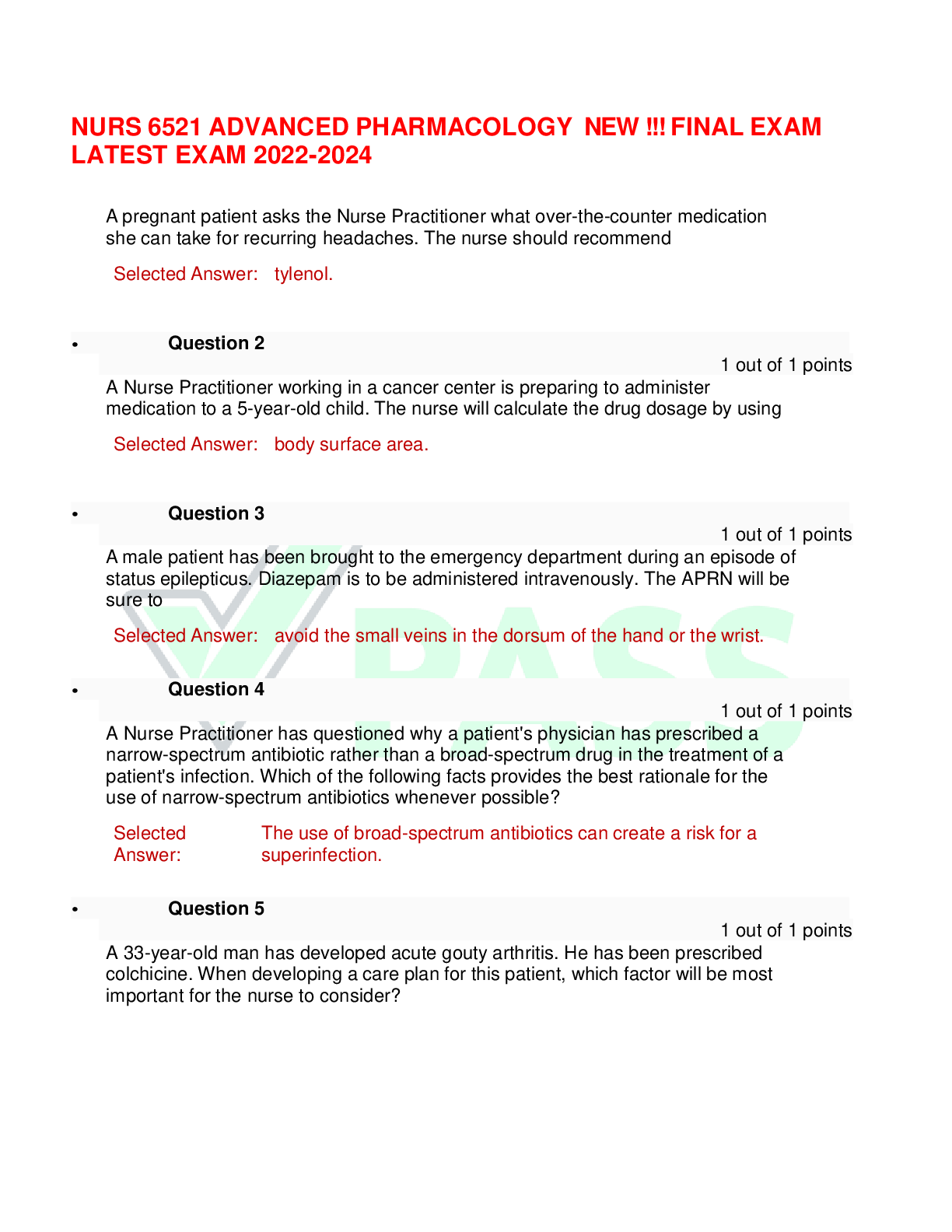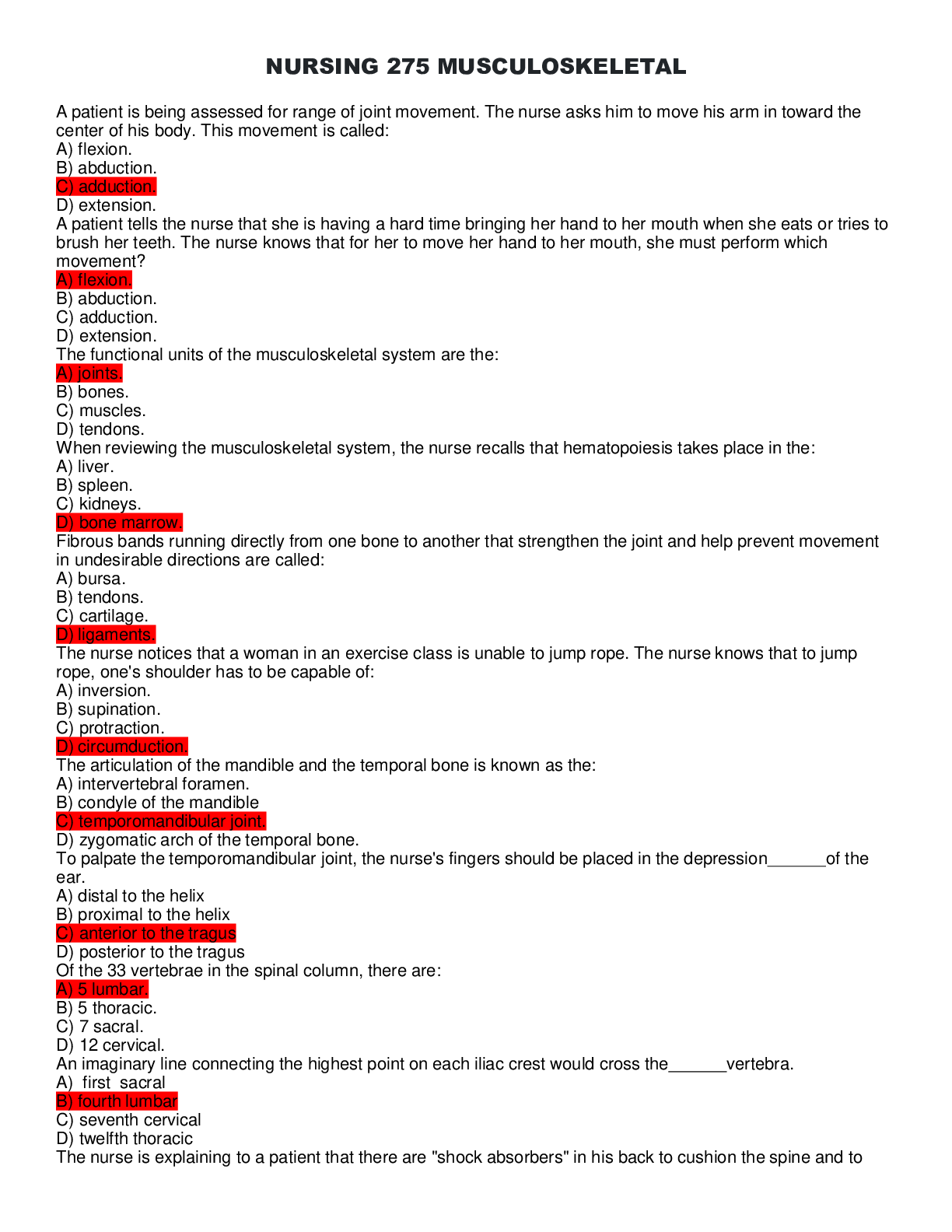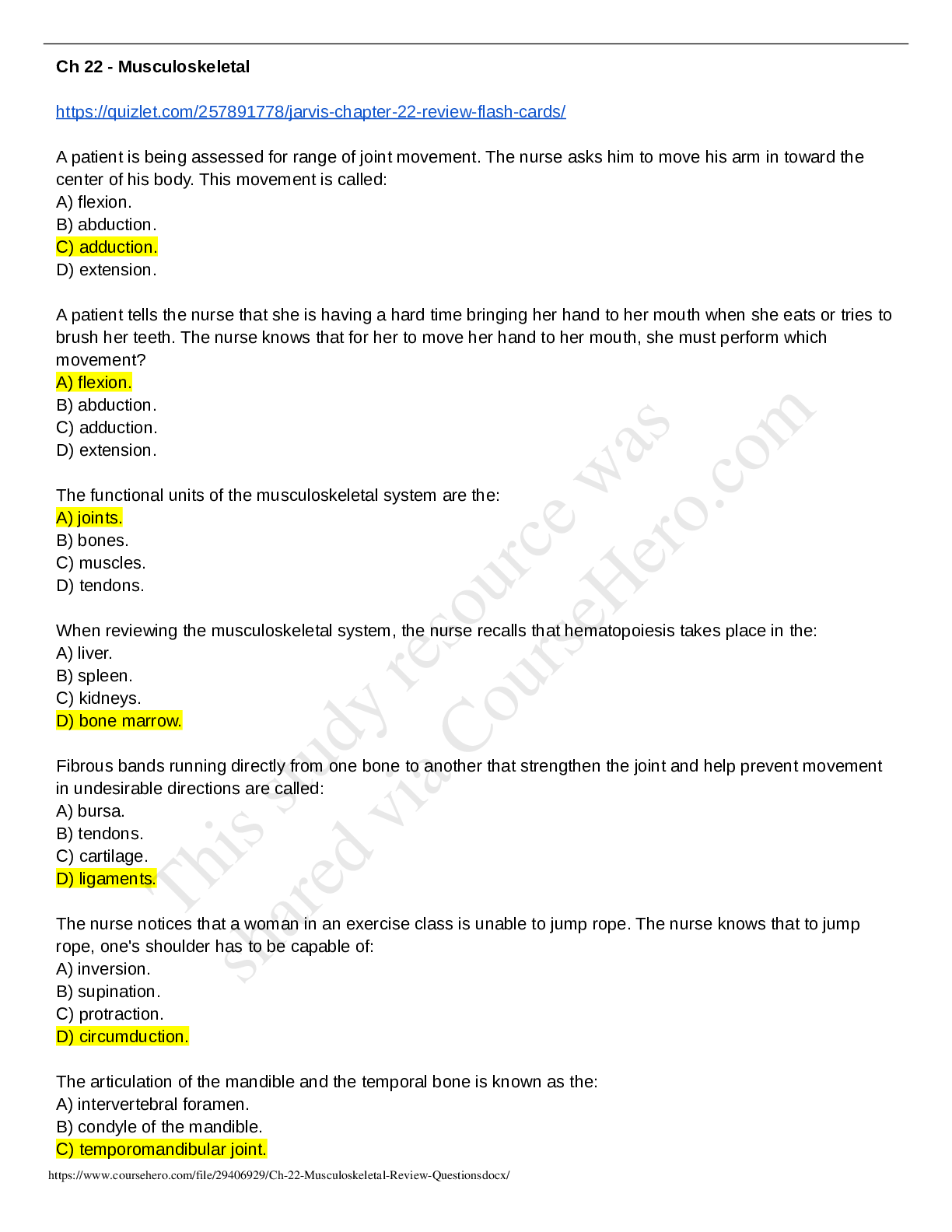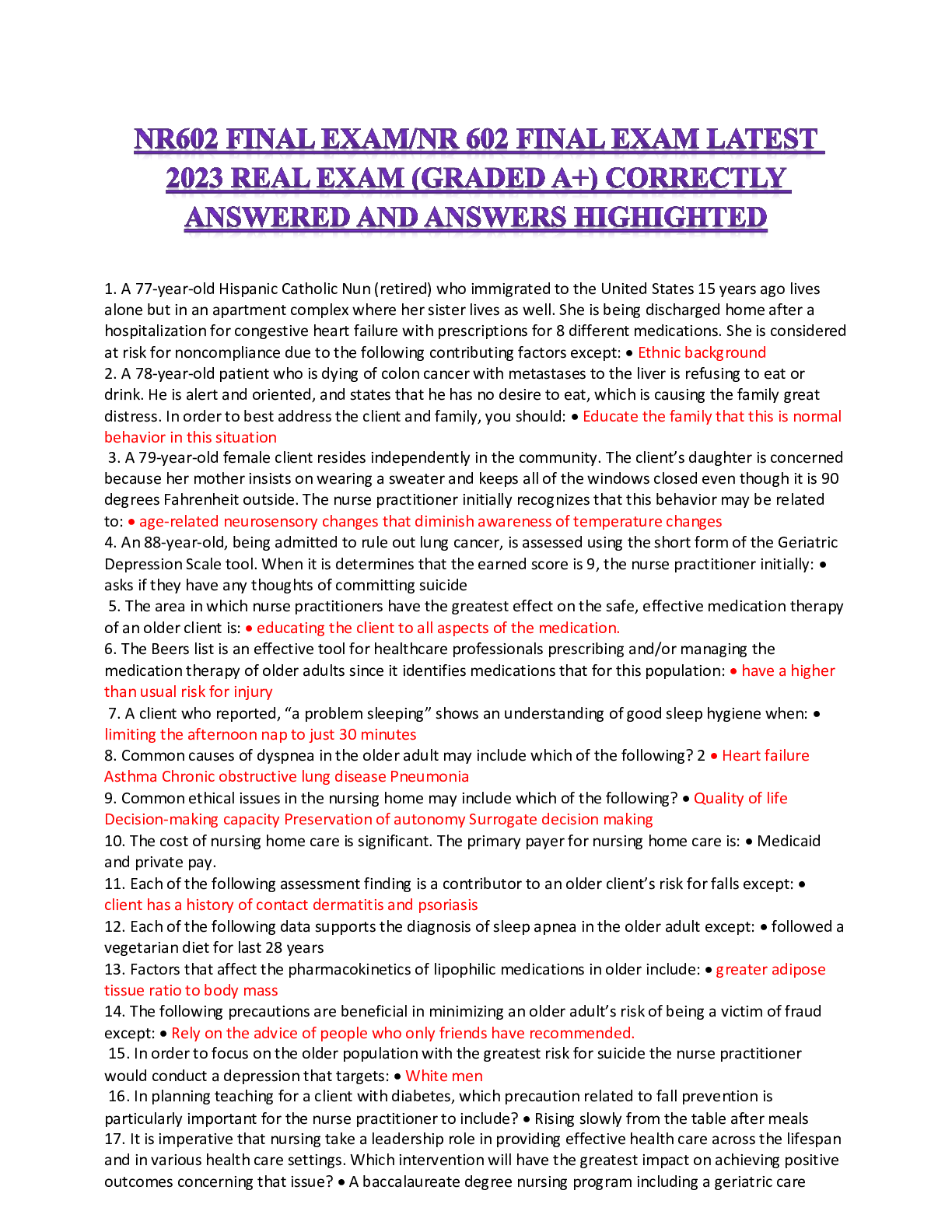Physics > QUESTIONS & ANSWERS > TESTBANK / QUESTION BANK FOR Premed 95 Comprehensive P/S 2022/2023 1003 Questions with 100% Correct (All)
TESTBANK / QUESTION BANK FOR Premed 95 Comprehensive P/S 2022/2023 1003 Questions with 100% Correct Answers
Document Content and Description Below
TESTBANK / QUESTION BANK FOR Premed 95 Comprehensive P/S 2022/2023 1003 Questions with 100% Correct Answers what cues are taken into account when "perceptually organizing"? - ✔✔depth, form, mot... ion, constancy Look at Psychological Disorder quizlet - ✔✔Quizlet what do binocular cues provide? - ✔✔depth perception(due to retinal disparity)- ability to perceive the relative distance of objects in one's visual field what is convergence? - ✔✔gives depth perception based on how much eyeballs are turned what do monocular cues provide? - ✔✔relative size- closer objects are perceived as bigger. interposition (overlap) - the perception that one object is in front of another. The object in front is closer. relative height - things higher is perceived to be farther away than those that are lower. shading/contour motion (motion parallax) - things farther away move slower, closer moves faster. constancy - the perception of an object does not change even if the image cast on the retina is different. Shape, size, and color constancy. Sensory Adaptation - ✔✔Our senses are adaptable and they can change their sensitivity to stimuli. Senses are touch, smell, hearing, & sight. what is proprioception? - ✔✔sense of "self in space" what is just noticeable difference? - ✔✔smallest difference at which you can notice a change in sensation Weber's Law - ✔✔The ratio of the JND(delta i) / initial intensity = k (constant) what is absolute threshold of sensation? - ✔✔The minimum intensity of stimulus needed to correctly detect it 50% of the time. influenced by sensory factors (experience, expectations, motivation, and alertness.) what is a subliminal stimulus? - ✔✔stimulus that is just below our absolute threshold of sensation Types of Somatosensation (the external body interaction with its environment) - ✔✔Temperature (thermoception), pressure (mechanoception), pain (nociception), and position (proprioception) non adapting neuron - ✔✔neuron fires at constant rate slow adapting neuron - ✔✔neuron fires rapidly at first then tapers off fast adapting neuron - ✔✔fires as soon as stimulus starts, stops, then starts up again once stimulus stops what portion of the inner ear helps determine strength of rotation/movement of head? - ✔✔endolymph inside semicircular canals otolithic organs - ✔✔utricle and saccule- help with detection of linear acceleration and head positioning. what is signal detection theory? - ✔✔Effect on non-sensory factors (motives, experiences, & expectation) on perception. Allows psychologists to explore response bias Response bias - ✔✔subjects respond in a certain way due to non-sensory factors Signal is present Hit - subject is correct Miss - subject is incorrect Signal is absent Correct negative - subject is correct False alarm - subject is incorrect what is the liberal strategy (signal detection theory?) - ✔✔always saying yes, youll get all the hits but might get false alarms what is the conservative strategy? (signal detection theory) - ✔✔always say no unless 100% sure, will correctly get all false rejections but might get some misses what is bottom-up processing? - ✔✔stimulus affects our perception, data driven, Inductive reasoning. what is top-down processing? - ✔✔uses background knowledge to influences perception. deductive reasoning. Ex: playing a game of hangman Gestalt's Principles - ✔✔A type of top-down processing. Tries to explain how we perceive things the way we do. Gestalt's Law - ✔✔Similarity - items similar to one another are grouped together. Pragnanz- reality reduced to simplest form possible. Ex: Olympic rings (instead of complex shapes, the brain organizes the olympic rings into 5 circles.) Proximity- items that are close together are grouped together. Continuity - lines follow the smoothest possible path. Closure - Mind fills in missing information. Ex: filling in a triangle when there is none. Symmetry - Mind perceives an object as being symmetrical and forming around a centre point Contextual effect - ✔✔the context (situation) in which stimuli are presented contribute to how people perceive those stimuli. what is the conjunctiva? - ✔✔thin layer of cells covering cornea Cornea - ✔✔At the front of the eye, bends and focuses light rays Anterior chamber - ✔✔the space between the cornea and the iris, filled with aqueous humor (supplies nutrients and maintains eyeball shape) Pupil - ✔✔regulates the amount of light entering the eye Iris - ✔✔gives the eye its color & controls the pupil size Lens - ✔✔Focuses light on the fovea of the retina. Changes its shape to adjust light via the supersensory ligaments. Ciliary body - ✔✔produces aqueous humor what is the posterior chamber? - ✔✔area between iris and lens, filled with aqueous humor what is the vitreous chamber? - ✔✔filled with vitreous humor, jelly like substance, gives pressure to eye Retina - ✔✔The back area of the eye filled with photoreceptors; contains rods and cones Macula - ✔✔area of retina with high cone density but some rods fovea - ✔✔special part of macula that has ONLY cones cones - ✔✔detect color, high detailed rods - ✔✔detect light, not as fine detail choroid - ✔✔black pigmented network of blood vessels used to nourish the retina Sclera - ✔✔white of eye - attachment site for extrinsic eye muscles Visual pathway - ✔✔light hits rods in retina -> rods turn off -> bipolar cells turn on -> retinal ganglion cells turn on -> optic nerve -> optic chaism -> optic tract -> LGN -> visual cortex. trichromatic theory of color vision - ✔✔3 cones (red, blue, green) that combine to make all the colors we see. opponent process theory of color vision - ✔✔6 colors in pairs: red-green, blue-yellow, and black-white. When one member of a color pair is stimulated, the other member is inhibited. what happens to retinal when struck by light? - ✔✔converts from cis-retinal to all trans retinal what are optic discs? - ✔✔large membrane bound structures located inside rods/cones. contain proteins that fire APs to brain Differences between rods & cones - ✔✔Rods contain rhodopsin. Cones contain photopsin Retina contains more rods than cones Rods- detect light (black/white vision). Cones- detect color but also some light. rods have a very ___ recovery time compared to cones, - ✔✔slow. which is why takes time to adjust to a dark room Location of cones & rods - ✔✔Cones - located in fovea Rods- located in periphery (light goes through a bunch of axons and loses energy) there is a blind spot in the eye where - ✔✔the optic nerve connects to the retina (no cones or rods) why is there higher resolution at the fovea? - ✔✔no axons in the way of light entering the right visual field goes to the __ side of the brain - ✔✔left. Vice versa for the left visual field. light from the left visual field will strike.. - ✔✔the nasal side of the left eye and the temporal side of the right eye. light from the right visual field will strike - ✔✔the nasal side of the right eye and the temporal side of the left eye. nerves from the nasal retinas cross over at the - ✔✔optic chiasm The 3 elements of feature detection - ✔✔color - (cones) form - parvocellular cells. High spatial resolution (fine detail examining an object) but low temporal [Show More]
Last updated: 1 year ago
Preview 1 out of 103 pages
Instant download

Buy this document to get the full access instantly
Instant Download Access after purchase
Add to cartInstant download
Reviews( 0 )
Document information
Connected school, study & course
About the document
Uploaded On
May 27, 2022
Number of pages
103
Written in
Additional information
This document has been written for:
Uploaded
May 27, 2022
Downloads
0
Views
65

.png)
.png)
.png)
.png)
.png)
.png)
.png)
.png)
.png)
.png)
.png)













